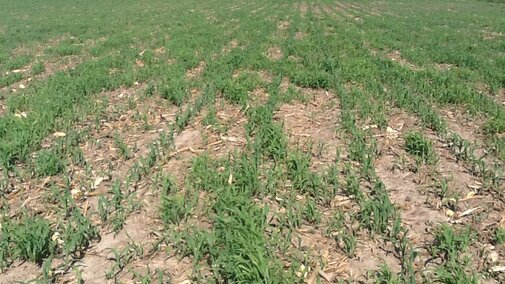John Wilson, Extension Educator in Burt County: Corn planting is about done and soybeans planting is about 85% done. Still a few wet fields. In alfalfa and my CRP (pure stand of alfalfa) there is a lot of alfalfa weevil feeding. I haven't looked in any other fields to confirm how widespread this is. We are just in very early bloom so if it is in other fields, a cutting rather than a treatment would be my suggestion, then watch regrowth to see if treatment is needed. (See May 16 CropWatch article, Scout Diligently for Alfalfa Weevils in May and June.)
Ron Seymour, Extension Educator in Adams County: Field crops were surveyed on May 25. Soybeans were in the unifoliate stage and looked good. Wheat was headed out and blooming. Field corn was in the the 3- to 4-leaf stage and in most cases looked very good. Some of the corn fields had quite a few weeds. It was surprising to find an extensive infestation of shepard's purse in one field but not as surprising to find huge populations of volunteer corn in some fields. In some cases the volunteer corn population was so thick it was difficult to row the planted crop. (5/29/18)
Randy Pryor, Extension Educator in Saline County: The south half of Saline County has been very dry along with many areas in Jefferson County. This past week the ET gage dropped 2.6 inches in eight days or an estimated 2.3 inches in one week. Fortunately crop water use is low at this point in the season. Stands of corn and soybeans are good and quite a bit of the corn is at V4 stage. Winter wheat is heading or starting to head during moisture stress conditions. We have experienced yield losses compared to normal on first cutting alfalfa and pasture grass growth. There are many concerns about the dry, hot weather pattern and below-normal soil moisture and the effect it will have on dryland crops this year. (5/29/18)
Gary Stone, Extension Educator in Scotts Bluff County: We’ve had quite a bit of moisture the last two weeks – 4 inches – and are expecting more today. Corn is up for the most part and it and pastures are looking great. Dry beans are starting to go in. Sugar beets are up. (5/29/18)
Sarah Sivits, Extension Educator in Dawson County: Planting is mostly done. Corn is from V1-V4; soybeans are from emergence to V3; and wheat is looking better. Growers took their first cutting of alfalfa and put it up before this week's rain. Areas in Hall County had 3 inches of rain; others less, all of which we’re thankful for.
Steve Melvin, Extension Educator in Hamilton County: Planting is mostly done and ridge tillers are cultivating. Some growers are spraying a couple times to clean up volunteer corn in soybeans. The volunteer is so thick in some of these fields that you can’t see the rows. Precipitation has been varied. Monday night Grand Island got 0.5 inch of rain while Merrick and Hamilton counties didn’t really get anything. Further south, in Nuckolls County, they haven’t gotten any rain and grasses are going dormant. One grower reported leaves were falling off the alfalfa and that the wheat is struggling a bit.
Aaron Nygren, Extension Educator in Colfax County: A few growers are still planting; others are spraying. In Saunders County there have been reports of some anhydrous burn, even with fall-applied anhydrous, and pivots are running heavy.

